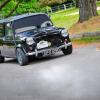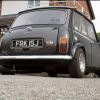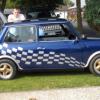Well i was wondering how you bond a spaceframe to a shell?
Alex
Bonding A Fibreglass Shell To A Spaceframe
#1

Posted 29 March 2014 - 01:34 AM
#2

Posted 29 March 2014 - 08:03 AM
Heavy duty cable zip ties and then fibreglass over them?
#3

Posted 29 March 2014 - 08:41 AM
Failing that, there are a lot of specialist adhesives that you can use for grp to steel or grp to alloy.
#4

Posted 29 March 2014 - 09:02 AM
Id want it removable so you can change panels,,, my mate does National Hotrods (fibreglass panels on a spaceframe), all the panels can be removed in half an hour, simply by undoing a few m10 boltsI'd think it'd be better not to. Wouldn't it be better if the grp was non-structural and removable?
Failing that, there are a lot of specialist adhesives that you can use for grp to steel or grp to alloy.
Edited by cal844, 29 March 2014 - 09:04 AM.
#5

Posted 29 March 2014 - 02:41 PM
There are two basic types of GRP construction.
The first is where the metallic structure, what there is of it, is bonded into the GRP as a part of the design and the GRP then becomes a load-carrying structure with the fully integrated metal being used as additional strength and to form hard attachments for suspension, engine, gearbox, steering, etc.. For this to work the entire structure must be subject to a full stress analysis in order to be confirmed as safe. This has developed into the all-composite F1 and International Sports Cars (think le Mans cars) of today. An early car which used this form of design was the beautiful Lotus Elite of the late '50's (how I wanted one of those back then).
The second type of construction is one in which the steel or aluminium chassis is the load carrying structure and the GRP is just for the lightweight non-structural body and trim. With this there are mounting points, normally lugs, which are a part of the metal structure and the GRP body is simply bolted to these and can be easily removed if or when required. This was an early application of GRP where the old chassis of the day, for example the Morris 8 or Austin 7 (pre-war one, not the Mini Seven) were sometimes fitted with after-market sports bodies and the engines and suspension modified thus creating a low-cost DIY sports car in the '50's and early '60's. One of the problems was that those old chassis would 'flex' over bumps and fatigue of the GRP at its mounting points often followed. Then along came the A-H Sprite which was more affordable than the MG's had been and the GRP 'specials' disappeared.
I hope this helps.
1 user(s) are reading this topic
0 members, 1 guests, 0 anonymous users

















